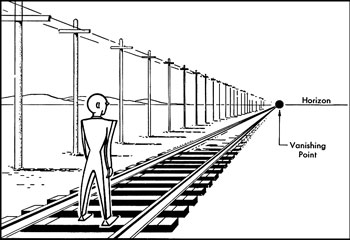
In the normal process of visual development, infants acquire the ability to perceive depth from motion at 3 months of age. At about the same age they acquire the ability to see depth from stereo vision for objects that are nearby, i.e., between them and their fixation point. They do not acquire the ability to see depth from pictorial cues until much later, at about 7 to 9 months of age. Pictorial cues to depth are the cues we use when interpreting photographs and images. Perspective is one such cue, as when one sees the sides of a railroad track converge toward each other as their distance from the observer increases. Another cue is occlusion, in which a nearer object covers up a portion of an object that is further away. The genetic program that governs this pattern of visual development is normally as reliable as it is powerful. But a single nucleotide mutation on chromosome 9 can profoundly alter the program, leading to a condition known as bathosmigia, in which the normal depth relations are inverted or, on occasion, simply scrambled. Near objects are seen as far, and far as near. An object that is occluded appears to be in front of the object that occludes it. The train tracks appears to get closer as the lines converge.

Although the effects of bathosmigia are largely unpredictable, there is a marked tendency, when looking directly at any particular object, to perceive that object as closer than objects that are, in fact, in front of it. The occlusion of near objects by farther-away objects means that the patient is engaged in a process of active reconstruction of the parts of the object that are actually hidden from view. Fortunately, bathosmigia is rare, since the bathosmigic patient, although enjoying normal intelligence, is dramatically impaired in visuo-motor coordination, and is usually dependent almost completely on others for the simple necessities of everyday life.